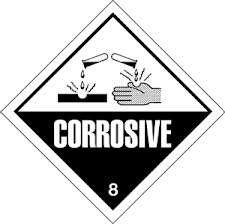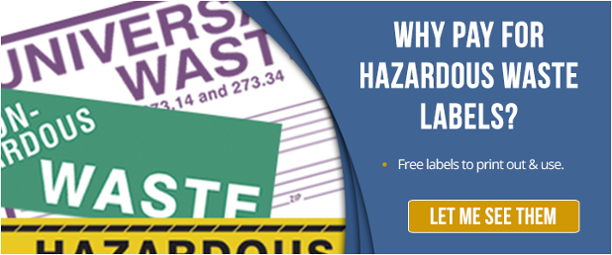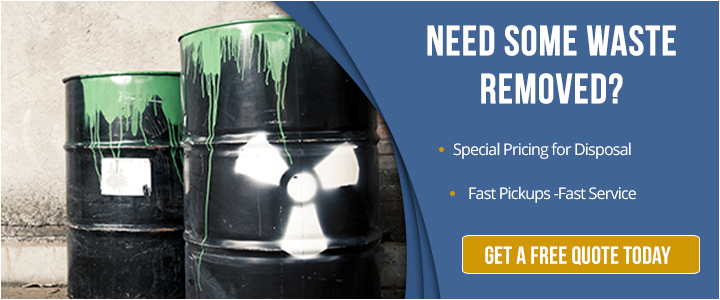Understanding the definition of corrosive substances is paramount in determining the appropriate disposal methods for industries that generate this type of hazardous waste.
According to the Occupational Safety and Health Administration (OSHA), the corrosive definition is “a chemical that causes visible destruction of, or irreversible alterations in living tissue by chemical action at the site of contact.”
Under the U.S. Department of Transportation hazard class system, corrosives are listed as “Class 8.” If your company handles corrosive substances and generates waste from these materials, it is important to follow strict guidelines for handling, storing, transporting and disposing of them. Not doing so can result in environmental damage, injuries and a bruised public image.
Examples of Corrosive Substances
Corrosive substances can be either acids or bases. Acids have a pH of less than 7, while bases have a pH of greater than 7.
than 7.
Some common corrosive acids found in industrial environments and their uses include:
- Hydrochloric acid (HCL): Refining cane sugar, making glue and synthetic rubber, manufacturing plastics, turning starch into glucose
- Sulfuric acid (H2SO4): Manufacturing lead acid batteries, explosives, fertilizers, glue, dyes and paints, as well as the refining of petroleum gas and the curing of metal
- Nitric acid (HNO3): Manufacturing fertilizers, explosives and dyes, as well as dissolving most metals like gold and platinum if mixed with HCL
Some common corrosive bases found in industrial environments and their uses include:
- Ammonium hydroxide (NH4OH): Production of detergents, textiles, soaps, ceramics, inks, explosive articles and pharmaceuticals, as well as regulating food acidity
- Potassium hydroxide (KOH): Production of soaps, shaving creams, soil remediation, fertilizers, biodiesels and chemical cremation
- Sodium hypochlorite (NaCIO or NaOCl): Production of bleach, disinfectant and antiseptic, as well as used in waste management and as a pesticide
As you can see, corrosive materials are used in several ways across multiple industries, from consumer product production to waste management, agriculture and manufacturing. Having a proper waste disposal plan in place begins with understanding how they should be stored, transported and disposed of at the appropriate facility.
Storage of Corrosives
One of the most important procedures to be followed when storing corrosive chemicals or substances is to keep them in a designated area, separated from other incompatible materials. This area should be well-ventilated and equipped with proper spill control measures in case an accident occurs. These measures should include having personal protective equipment (PPE), absorbent materials to contain the spill and the appropriate neutralizing agents on hand.
Ensure this storage area is away from any sources of heat or ignition since many corrosive substances can react violently when exposed to high temperatures.
Choose containers made of compatible materials. For example, containers that store acids should be made of polyethylene or glass, while containers that store bases should be made of stainless steel or polypropylene.
Use tightly sealed containers, and choose the appropriately sized containers. Large containers should be used for bulk storage, while smaller containers can be used for storing smaller quantities.
Finally, make sure all corrosives are labeled properly. Labels should include the name of the substance, the date of storage and any other relevant information including emergency contacts. Free printable hazardous waste labels are available by clicking the offer below.
Transporting Corrosives
The U.S. Code of Federal Regulations divides Class 8 Corrosives into three packing groups according to the degree of hazard in transport. Packing Group I indicates the greatest danger, with Group III indicating minor danger.
Knowing the difference is important because whether shipping a hazardous material by ground or in the air, you must accurately identify the proper packing group of the hazardous material.
Packing Group 1: Materials that cause full-thickness destruction of intact skin tissue within an observation period of up to 60 minutes, starting after the exposure time of three minutes or less.
Packing Group II: Materials other than those meeting Packing Group I criteria that cause full-thickness destruction of intact skin tissue within an observation period of up to 14 days starting after the exposure time of more than three minutes but not more than 60 minutes.
Packing Group III: Materials, other than those meeting Packing Group I or II criteria:
- That cause full-thickness destruction of intact skin tissue within an observation period of up to 14 days starting after the exposure time of more than 60 minutes but not more than 4 hours; or
- That do not cause full-thickness destruction of intact skin tissue but exhibit a corrosion rate on steel or aluminum surfaces exceeding 6.25 mm (0.25 inch) a year at a test temperature of 55°C (130°F).
The U.S. Department of Transportation also has several requirements while transporting corrosives, including:
- A shipping manifest: In 2018, the Environmental Protection Agency began implementing a national e-manifest system that tracks hazardous waste shipments electronically. For several decades, the EPA has imposed a manifest system that tracks cradle to grave hazardous waste.
- The proper hazardous waste labels: The DOT implements several hazardous waste label requirements that generators must follow when marking each package of waste before transporting it off-site.
- The correct placard: The Class 8 placard, in particular, features a symbol that shows liquids spilling from two glass vessels and causing damage to a hand and a piece of metal. The placard also is in black and white and features the number “8.”

- California requirements: The California Department of Toxic Substances Control (DTSC) also provides its own set of requirements that generators must follow, including:
- The composition and physical state of the waste
- A statement that calls attention to the hazardous properties of the waste
- Name and address of the generator
Using a disposal company for the transportation of corrosives is not only essential but also required by law. Hazardous waste regulations implemented by agencies like the U.S. Environmental Protection Agency (EPA) and the Department of Transportation (DOT) mandate that hazardous waste must be transported by a licensed and insured transporter.
This ensures that corrosive waste is handled and transported safely, minimizing the risk of environmental contamination, accidents and injuries. Let’s take a closer look at what a reputable disposal company can offer your business.
Disposal Of Corrosives
A reputable disposal company will have the necessary permits, trained personnel, and appropriate equipment to handle and transport corrosive substances safely. It is crucial for companies to work with a reputable disposal company for the transportation of their corrosive waste, not only to comply with legal requirements but also to protect the environment, the public and their own reputation.
The disposal company will collect and transport the waste to a licensed hazardous waste facility. There, the corrosive waste will be treated and disposed of based on the characteristics and composition of the waste.
Treatment processes vary but may involve the neutralization of the acids or bases to reduce their corrosivity. The treatment, storage and disposal facility (TSDF) may then dispose of it in a secure landfill that is designed for that particular type of waste. These secure landfills have precautions in place to prevent any substances from leaching into the surrounding soil and into the environment.
So what do the best disposal companies offer, and what should you look for in this important partnership?
The hazardous waste disposal company you work with must be licensed and regulated. Check to ensure a disposal company is registered using the California Department of Toxic Substances Control’s registered hazardous waste transporter database. The database also provides information about when the transporter’s registration expires, its registration number and its location.
A hazardous waste transporter registration is valid for only one year, so conducting annual environmental audits of vendors handling your hazardous waste and transporting it to a disposal facility is a good idea. As can happen with any business, a reliable environmental vendor can lose its approved registration status if it does not meet certain requirements.
Hazardous waste disposal companies should also:
- Prepare labels, manifests and other paperwork required during shipment
- Identify wastes through sampling and testing
- Transport the wastes to the proper recycling and disposal sites
- Offer prompt pickups
- Address any cost concerns you have
- Assist you with packaging your waste so you can avoid fines and save money
A high-quality hazardous waste disposal company will also offer a walk-through program. During a walk-through, a hazardous waste expert will evaluate your company and offer important insight into areas of focus, including corrosive waste storage evaluation, emergency readiness and hazardous waste evaluation.
This information can be used to develop important strategies for avoiding hazards that come with working with corrosive substances, as well as improving safety for workers and improving your company’s compliance.



Comment